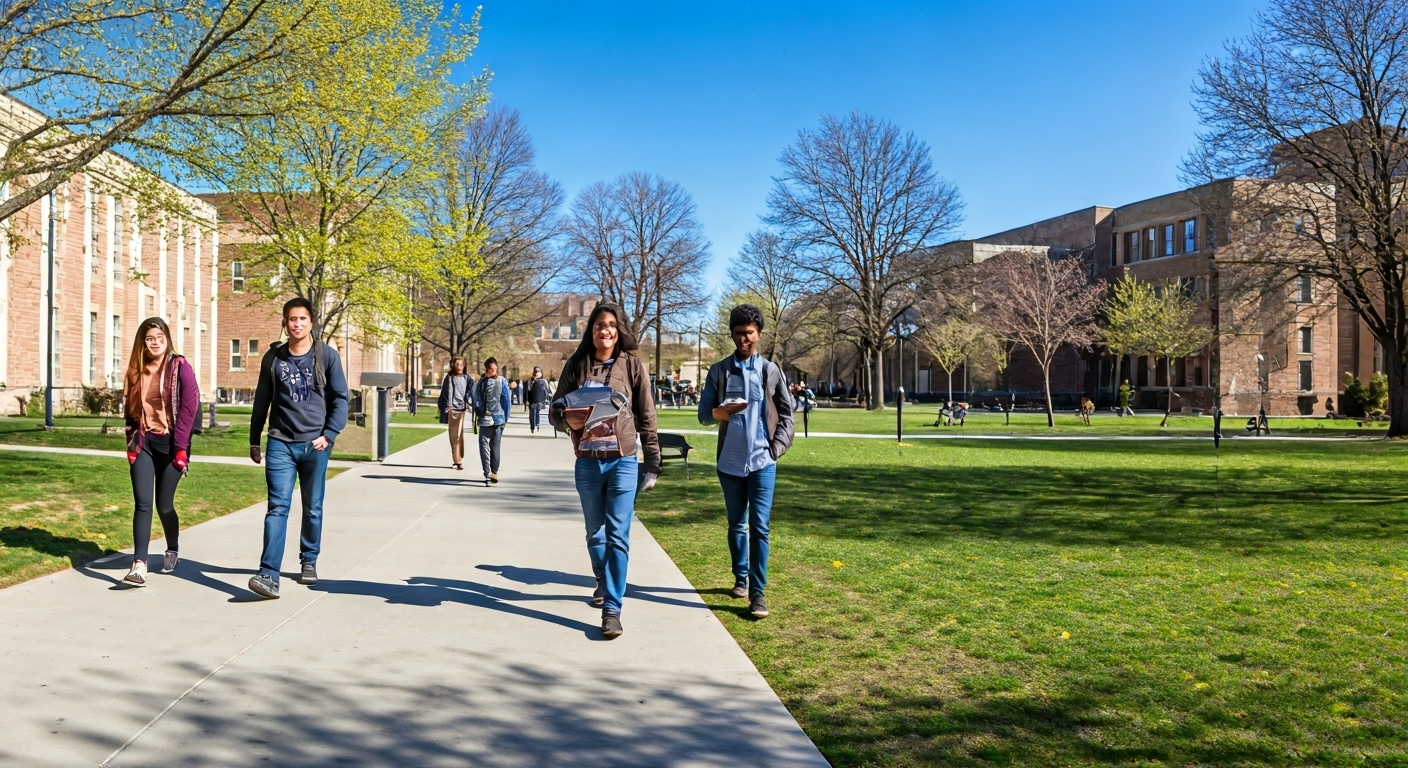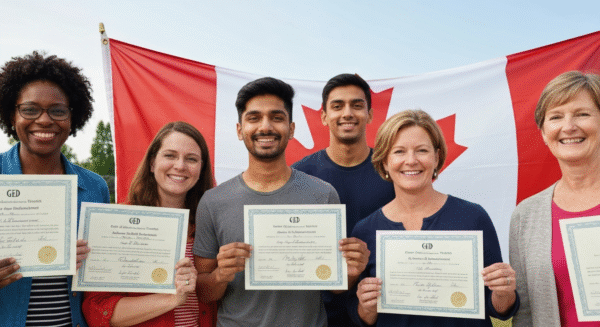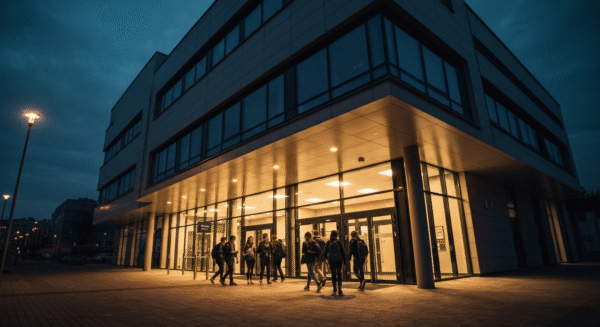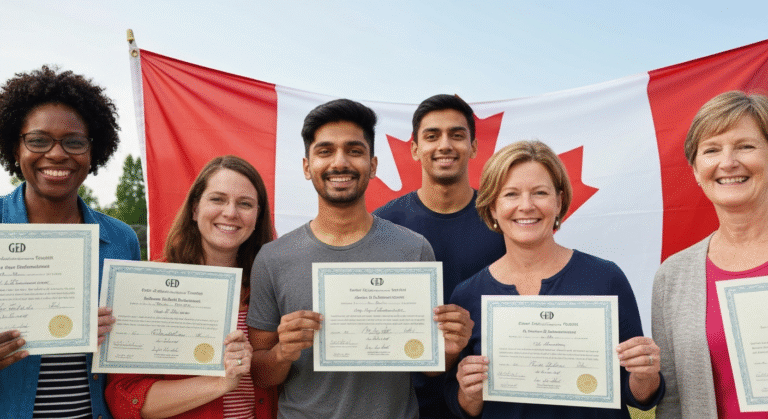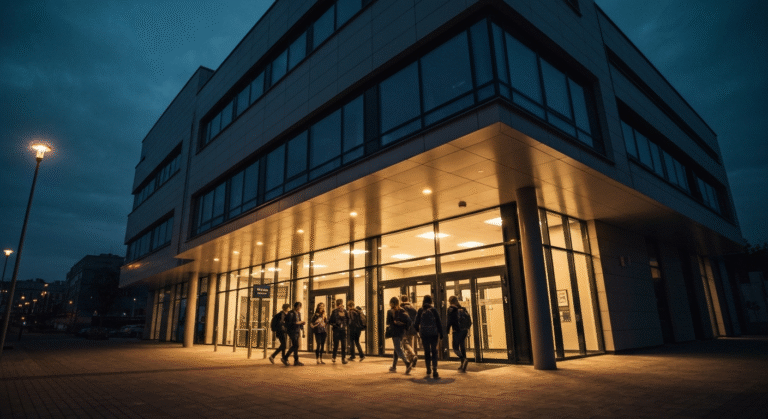Key Highlights of Canada Education Rate
- Canada is set to lead the G7 in adult education Canada by 2025. Around 57.5% of adults aged 25 to 64 have finished postsecondary education. This means the people in Canada reach a high level of educational attainment.
- The country also has a high literacy rate. About 94% of people have at least a high school diploma. This helps make sure many people get quality education.
- International students now make up a large part of postsecondary education. They play a key role in supporting higher education trends in Canada.
- There are differences in every province. Ontario and British Columbia have the most people with degrees compared with other places in the country.
- The gap between men and women in educational attainment is much smaller now. Even so, women are more likely to finish postsecondary education than men.
- There are hard times for skilled trades and vocational training. Fewer people are getting apprenticeship certificates. This could hurt jobs and change outcomes in the labor market.
Introduction
Canada is known for its good education system. A lot of Canadian adults have a college or private universities degree. Canada education statistics show that more people in the country get a university degree each year. There is a stronger focus on quality education in every part of the country.
As more skilled workers are needed, the Canada Education Rate lets us see changes in what people learn and how different their skills are. This has an effect on the workforce and also on all parts of society.
This article will talk about the latest data. It will look at how things are different in each province. It will also talk about how things are different for men and women. This article will look at how international students have a bigger role in Canadian education now.
Understanding the Canada Education Rate in 2025
In 2025, Canada will set a new level for quality education and be known for inviting people from everywhere. The country has the highest number of men and women with some type of schooling after high school. There is also steady growth in the levels of education in many provinces.
The government of Canada has helped keep this progress moving forward. Using data from education indicators has shown this change. Knowing about these trends helps people see both the strengths and problems in the way education works for Canadian citizens.
What Is Canada’s Education Rate and Why It Matters
The Canada Education Rate tells us how many people in Canada, aged 25 to 64, have finished different levels of education. This can be a high school diploma or a university degree. By looking at these numbers, we can see how the education system is working and how ready people are for work, which reflects on the overall employment rate.
Right now, Canada is first among the G7 countries when it comes to educational attainment, particularly in terms of tertiary education. About 57.5% of working-age adults in Canada have a college or university credential. This number comes from the 2021 Census. In this group, around 32.9% have at least a bachelor’s degree. The rate has gone up in recent years.
When you look at the number of people with a university degree, Canada takes the fourth spot in the G7, just behind the University of Toronto. The United Kingdom leads here with 41.3%. The United States is next at 39.5%, and Japan follows with 34.2%.
Why is this important? When more people in the country reach higher levels of education, the country gets stronger. It helps the economy grow. People get better job security and life becomes better for all. The more Canadians who finish university degrees, the better the country can deal with changes in the world’s economy.
National and Global Education Performance Overview
Canada’s education system is known to be one of the best in the world, rivaling that of South Korea. Because of this, it often ranks high around the globe. The country has a strong college sector, and it also brings in many international students. This helps build a good name for its higher education. Statistics Canada says that more adults in Canada have degrees than in most other developed countries.
A text table below shows the percent of adults who have a college or university degree in the G7 countries:
Country | Adults 25–64 with College/University Credential (%) | Bachelor’s Degree or Higher (%) |
|---|---|---|
Canada | 57.5 | 32.9 |
United Kingdom | 48.7 | 41.3 |
United States | 49.7 | 39.5 |
Japan | 50.5 | 34.2 |
Germany | 32.0 | 28.0 |
France | 38.0 | 31.0 |
Italy | 20.0 | 18.7 |
Canada has built a solid system with help from government rules and set standards in schools. This makes sure that the country always has people who are well trained and ready to work. These results show that Canada is in a strong place when it comes to education worldwide.
Literacy and Educational Attainment
Canada has a high number of people who can read and write well. Most of the adults in Canada finish secondary education. Now, more people want to go on to study after that. Statistics Canada says that educational attainment is still rising. This is because of changes happening in Canada and also from outside the country.
If you look at the numbers for literacy and how many people finish school, you see that secondary schools and postsecondary programs are important. They help Canada’s workers and shape how people move forward in life. Now, let’s look at some statistics about literacy and job training trends.
Canada’s Literacy and High School Completion Rates
Literacy is a big strength in Canada. By 2021, about 94% of adults have at least a high school diploma. This is a high number. It helps Canada stand out in the world. It also shows that their secondary schools are strong.
High school completion rates in Canada are still good. Around 81% of all students finish high school. Girls have a higher rate at 84%. Boys are a bit lower at 77%. Over time, these numbers keep getting better. This means the country will have more people who can do different things and learn new skills. Canada’s spoken high school completion rate is higher than the average in the OECD. This shows that the country puts a lot into secondary education.
Numbers from Statistics Canada show that when Canadian adults have high literacy rates, more of them can go on to study more and work, too. If you finish secondary school and read well, you get a better chance at quality education. You also have a better shot to do well at your job. This helps Canadian adults keep doing well as time goes on.
Post-Secondary and Vocational Attainment Trends
Canada’s post-secondary education system has changed a lot over the years, especially for university students. In 2021, around 57.5% of people from age 25 to 64 had finished some kind of post-secondary education. This could be from a university, a college, or an apprenticeship program. Back in 2000, there were only about 1.34 million Canadians in post-secondary schools. In 2021, the number went up to 2.17 million. The way people in Canada take part in the education system shows how much secondary education has grown over time.
Vocational schools and apprenticeship programs for skilled trades are facing some real problems. There are not as many young people getting apprenticeship certificates in jobs like construction, mechanics, or making things by hand. Older workers are leaving, but there are not enough new workers to take their place. Colleges are making new programs to help train people for these skilled trades and match what jobs need right now. Even with this, there is still a lot to do to get more people to work in skilled trades.
Even though there are these problems, there are still many people in Canada who finish secondary education. A lot of them also graduate from vocational schools. This helps Canada be at the top when it comes to educational attainment. It also helps grow a good and qualified workforce.
Regional and Demographic Variations
There are big differences in education between regions and groups in Canada. The level of educational attainment often shows differences between places. Provinces like British Columbia and Ontario have more people with postsecondary education. Areas like the Northwest Territories, through initiatives by the department of education, have fewer people taking part in higher education. A person’s background, such as their family income, can also affect the chances they have in education.
Because of this, people from Indigenous groups and low-income families do not always have the same chance for quality education as others. The number of people taking part in job and skills training programs also changes from place to place. This can change the overall rate of education across Canada. These facts show that there needs to be different plans for each area. This will help make sure everyone can get access to quality education.
Education Rates by Province
When you look at the provincial education comparison, you can see there are big differences between each place. In Ontario, the most adults aged 25 to 64 have a college or university credential. The number is 62.8%. This province also has the most people with a bachelor’s degree or higher, with the number at 36.8%.
British Columbia is next. There, 58.1% of people have a postsecondary credential, and 35% have a bachelor’s degree or higher.
Prince Edward Island and Nova Scotia are also doing well when it comes to people going to community college or university. The rate of educational attainment is 58.1% in Prince Edward Island and 56.7% in Nova Scotia. But people in Nunavut and the Northwest Territories have much lower levels of educational attainment. This is because of where they are and the kind of economy they have.
You can see some other differences too, like when you look at gender. Women are more likely than men to finish a university degree, and this happens in every province. In Canada, for people who are 25 to 34 years old, 39.7% of women who were born in Canada have a bachelor’s degree or even higher. But only 25.7% of men in that same group have a bachelor’s degree or more. The gap between men and women is getting smaller, but it is still there in most places in the country.

Visual suggestion: A bar chart can help show and compare the percentage of adults who have degrees in each province.
Gaps Among Indigenous, Racialized, and Rural Populations
There are still learning gaps for Indigenous people, certain racialized groups, and people in rural places. This happens even as there has been good change in recent years. More people finish high school now, but when it comes to a bachelor’s degree, the gap for these groups is getting bigger.
- In 2021, 73.9% of working-age Indigenous people finished high school. This number is higher than it was in 2016. But only 12.9% of them have a bachelor’s degree or higher.
- There is a big gap when you look at who has degrees. Around 12.9% of Indigenous people have a degree, but 27.8% of non-Indigenous people do.
- People who live in rural areas and some racialized groups are not often seen in secondary or postsecondary education. This makes it harder for them to get jobs and do certain work.
- Women and racialized people are less likely to get certificates for apprenticeships in skilled trades. Women hold only 2.4% of skilled trades certificates.
These gaps show that we need to focus on educational equity. All policymakers and community leaders who want to help should make this a top goal.
Role of International Students
International students are important in higher education in Canada. They make the campuses feel more exciting. These students also add more skill to the workforce. In 2021, there were over 620,000 international students at Canadian schools. This number is much higher compared to other years. Many of these students become permanent residents. This helps them take part in the job market and join degree programs in Canada.
Having these international students in Canada does more than just raise the Canada Education Rate. They help bring more money into universities. They also add to the mix of people you see on campus. Their days spent in higher education help move us all forward in one way or another. Now, it is time to look at the new changes. These changes will shape who gets to join and what rules guide this fast-growing area for international students in higher education.
International Enrollment Trends and Impact
In recent years, many international students have come to study at Canadian universities and colleges. A lot of them are from India and China. These students play a big part in shaping higher education in Canada.
- In 2021, there were about 620,000 international students in Canada. Back in 2015, this number was just 350,000.
- International students pay almost 40% of all the tuition fees in canadian universities. This helps bring in close to $4 billion every year for these schools.
- Two out of every three international students who finish their college or master’s degree get permanent residency within five years. The same happens for half of those who earn a bachelor’s degree.
- Many international students come with skills that are needed. They often pick degree programs that the job market wants, like in health care and STEM fields.
Now, the increasing number of international students helps keep Canadian postsecondary education strong. It also helps make sure the finances stay good and steady.
2025 Policy Changes and Their Effect on Education Metrics
The federal government and provincial authorities often make changes to their rules to help international students and to make the education system better. For the 2025 academic year, there will be some new changes in immigration and study permit rules. These new rules may also change the number of people who come for education.
These changes are made to attract more highly skilled international students. They help students from other countries stay and get permanent residency when they finish school. The government of Canada wants to make sure you get a quality education. It also works to help students get jobs by accepting foreign degrees and giving more support services.
When there are more international students, there will be more university graduates too. This adds to the mix of people with degrees in Canada, positively impacting labour market outcomes. As these international students later become Canadian citizens or get permanent residency, they step in to help the workforce. This is good for the country because it fills important job gaps. In the coming years, immigration will keep changing how the education system works and will also shape social results for all of us.
Barriers to Educational Equity
Canada has good education indicators, but there are still big problems. A lot of people have a hard time getting a good education. The cost of schooling can be high. There is also the digital divide. Some people cannot easily reach educational institutions. These issues make it harder for people from low-income, rural, or underrepresented groups.
People are working hard to find answers to these problems. There are new support services to help more people in Canada do well at school. If we want to keep Canada’s high education rate and get all the good things that come from having skilled and different groups of people, we have to face these big challenges. Now, let us look at the main problems out there and see what is being done to fix them.
Affordability, Digital Divide, and Accessibility
The cost of education is something that many families in Canada think about a lot. College and university can get very pricey. Tuition fees for students who live in Canada are about $6,580 each year. If you are one of the international students, you will pay almost $32,000. Public colleges can be less expensive for people, but you still have to pay for things like books, a place to stay, and things like computers. These extra costs can make school cost even more.
There is also the digital gap. Not every home has fast internet. Some people do not have a good device for online classes. During the pandemic, 24% of families with less money only had a mobile phone for school use. For families with higher incomes, that number was just 8%.
Key barriers include:
- Tuition fees are going up for students from Canada and for international students.
- There is not much technology or fast internet in the country or in rural areas.
- Students who have special needs or a disability face problems.
- There is not enough help for learning or education for grown-ups or for people who want to go back to school later in life.
Fixing these problems is important. This is the way we can make sure all people in Canada have a good chance to get quality education. This can be at public colleges or other schools. When we do this, people can get better jobs in the future.
Support for Underrepresented Learners
Initiatives that support underrepresented learners are important for building an inclusive education system in Canada. There are programs that focus on Indigenous peoples, students from low-income families, and those in racialized groups. These programs make sure that everyone gets fair access to quality education. The government of Canada and the provincial governments are working to lower tuition fees and offer scholarships. This helps ease the money problems faced by these students.
They also work with local organizations to offer good mentorship, which helps young adults do better in school and have more success in the labour market. These actions help close the gaps in the education system. They support diversity and give everyone hope for a better future.
Canada’s Education Outlook (2025–2030)
There are expected changes in Canada’s education system from 2025 to 2030. The system will be more open and creative. More international students will come, helping to add diversity and new ideas. There is more demand now for programs in STEM and skilled trades. Because of this, provincial governments are working to provide better help for vocational and adult education.
These changes will give people more chances to get good jobs after their studies. This help will be very important for indigenous populations, who often face barriers. All these efforts will make it easier for everyone to get into the education system, and more people will do well in it.
Government Goals and Inclusive Education Strategies
The Government of Canada works with provincial governments and the Council of Ministers of Education to make learning better for everyone. They all want to help people feel included in education. The goal is to close the learning gaps by the year 2030.
Key strategies include:
- The country wants to make early childhood education and care open to all Canadians. This helps every child get the right start.
- There will be more help for Indigenous people, people living in rural parts, and groups that face racial bias.
- Some new programs will help more people get into skilled trades and fields like science, technology, engineering, and math.
- The plan will also make it easier for immigrants and people who finished school overseas to get their foreign credentials accepted.
These steps help every Canadian have a fair chance at a good education and better jobs. Inclusive education is not just the right thing to do. It is also very important for the future of Canada. It helps keep the country strong and able to compete in the world. Quality education gives people and communities more choices and new chances to do well.
Future Predictions Based on Current Trends
Canada will have more adults getting postsecondary education in the next few years. Most of this growth will be in health care, computer science, and STEM. These fields need many workers. A lot of students also choose these areas.
Over the next five years:
- The number of people in Canada who are 25 to 64 years old and have a bachelor’s degree or higher is set to go over 35%.
- There will likely be more international students. This will help make the campus feel more open to different groups and add to the number of people with degrees.
- Jobs in skilled trades are still open, which means we need to put more time and money into vocational schools and training.
- A lot of Canadian graduates want jobs that feel steady like health sciences, information technology, and education.
Canada is always looking for new ideas. The country also wants everyone to get higher education. Because of this, it will keep doing well in world education.
Conclusion
To sum up, knowing about the Canada Education Rate helps us get a clear look at the education system as it is now. The numbers and trends we went over show how people read, if they finish school, and also some differences in groups. When we look forward, it is good to think about how international students shape the numbers. A change in the rules can show up in how many people take part in the system.
By working for more fairness in the education system and by giving help to those who face more problems, Canada can make things better for all people. If you want to know more about this or talk about it, you can get in touch for a consultation!
Frequently Asked Questions
1. What is Canada’s literacy rate in 2025?
Canada’s literacy rate in 2025 is one of the best in the world. Statistics Canada says that 94% of adults have a high school diploma. This high educational attainment shows the country is strong in secondary education. It also means many people in Canada can move up to higher education.
2. Does Canada include trade certifications and college diplomas in education rates?
Yes, in Canada, the numbers for education include things like apprenticeship certificates, college diplomas, and university degrees. College graduation rates in Canada are a key figure because they show how many finish school in this way. Skilled trades also play a big part in this field of study. A secondary education can help people get into skilled trades and some other fields.
3. How has immigration influenced Canada’s education profile?
Immigration has played a big part in growing the education system in Canada. There are now more international students and new immigrants coming into the country. Because of this, the number of university graduates and people with a higher level of education has gone up. Many of these people later become Canadian citizens. This helps bring more skills and a mix of different people to the country’s workforce.
4. What age group has the highest education rate in Canada?
Young adults who are between 25 and 34 years old have the highest educational attainment in Canada. This group is ahead when it comes to getting university degrees and advanced certificates. You can see the trend, as more young Canadians and canadian students are choosing higher education and many of them are doing well. This shows that educational attainment in canada is going up, mostly for young adults.
5. Is Canada’s education system becoming more skills-focused?
Yes, the education system in Canada now looks more at skilled trades, private career colleges, and vocational schools. The groups of study match the jobs people can get out there. This shows that the country knows job-ready skills matter as much as other classes from a school or college.
6. Do private schools or public schools contribute more to national education rates?
Public schools are the main way people in Canada get an education, starting with elementary school. Over 90% of students go to public schools. Private schools help with educational attainment, too. Public education is the start and base for most people. Public education leads to high educational attainment in Canada for many men and women.

